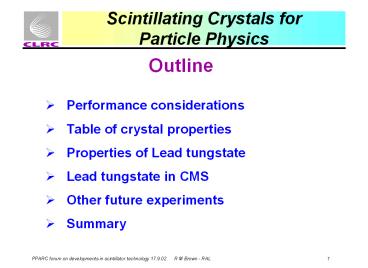Scintillating Crystals for Particle Physics - PowerPoint PPT Presentation
1 / 20
Title:
Scintillating Crystals for Particle Physics
Description:
Scintillating Crystals for Particle Physics Outline Performance considerations Table of crystal properties Properties of Lead tungstate Lead tungstate in CMS – PowerPoint PPT presentation
Number of Views:229
Avg rating:3.0/5.0
Title: Scintillating Crystals for Particle Physics
1
Scintillating Crystals forParticle Physics
- Outline
- Performance considerations
- Table of crystal properties
- Properties of Lead tungstate
- Lead tungstate in CMS
- Other future experiments
- Summary
2
Performance Considerations
- Light yield
- Speed (scintillation decay time)
- Radiation length / Molière radius
- Resistance to radiation-induced darkening
- Emission spectrum
- Cost (including implications for associated
detectors) - The relative weight given to these considerations
depends on the application. - The choice of crystal usually involves a
compromise
3
Crystal Properties
4
Lead Tungstate Properties
- Advantages
- Fast
- Dense
- Radiation hard
- Emission in visible
- Disadvantages
- Temperature dependence
- High refractive index
- Low light yield
- ? Photodetector with gain
5
Compact Muon Solenoid
ECAL
HCAL
Superconducting coil
Total mass 12,500t Overall Diameter
15.0m Overall Length 21.6m Magnetic field
4T
6
CMS ECAL Layout
Full projective geometry (Off-pointing by 3o)
6.3 m
Barrel 17x2 Crystal types End cap 1 Crystal type
7
PWO Production at BTCP - Russia
8
ALICE (A Large Ion Collider Expt for LHC)
PHOS
9
PHOS (Photon Spectrometer)
PbWO4 with PIN Diode readout
17 280 Crystals (180 x 22 x 22 mm3) 1.5 m3, 12.5
t
Crystals from North Crystals-Apatity
10
BTeV at Fermilab
Due to start in 2008
11
BTeV Electromagnetic Calorimeter
PbWO4 with pmt readout
10 000 Crystals (220 x 28 x 28 mm3) 1.7 m3, 14.3
t
Prototype crystals - Shanghai Institute of
Ceramics - Bogoroditsk (BTCP)
12
MECO (Muon-electron conversion) BNL
Search for m- N ? e- N (to 1 in 1017)
Crystal option 2300 crystals 120 x 30 x 30
mm3 BGO, PbWO4,(GSO) under consideration APD
Readout
Electromagnetic Calorimeter
Planned operation 2006
13
ANKE (Apparatus for studies of Nucleon and Kaon
Ejectiles)
Photon detector proposed for ANKE at COSY
(Jülich) Due to operate in 2004
14
Photon detector for ANKE
PbWO4 with fine-mesh pmt readout
800 Crystals (120 x 20 x 20 mm3) x 35 x
35 0.075 m3, 630 kg
0 0.5 m
15
Primex at Jefferson Lab
PbWO4/Lead glass 1200 PbWO4 Crystals 180 x 20 x
20 mm3 Ordered from Shanghai Institute of Ceramics
HyCal (Hybrid Calorimeter)
16
Comparison PbWO4, CeF3 , BaF2
Application to Medium Energy Physics (E(g) ? 1
GeV) (Novotny et al. NIM A486(2002) 131) BaF2
considered as the bench mark Conclude PbWO4
performs well, despite limited light yield CeF3
attractive, requires further development of
large homogeneous crystals Note Studies
elsewhere show light yield of PbWO4 (and energy
resolution) improved by doping with Tb or Mo -
at expense of speed
17
Super B Factory
(
)
BaBar 6580 CsI(Tl) Xtals Belle 8736 CsI(Tl)
Xtals
Super B Factory Candidate crystals Pure CsI with
APS LSO or GSO with APD
Scheme for Super B Factory Detector
18
Summary
- Several future high energy experiments require
very large volumes of crystal scintillator - The material of choice is PbWO4
- (Density, speed, radiation resistance, cost)
- Despite low light yield, PbWO4 is also proposed
for medium energy applications - Improvements in light yield through doping could
extend the range of applications of PbWO4 - Super B Factory might require a Fast, High
light-yield, Radiation-resistant scintillator
(CsI, GSO, LSO)
19
CMS Group at RAL - Interests
- Electromagnetic Calorimeter design
construction - Photodetector development
- Scintillator performance studies
- Light yield, decay time using HEP Test Beam at
ISIS - Radiation Hardness (in collaboration with
Brunel) - Dense scintillating glass RD
- (In collaboration with Sheffield, Dept of
Engineering Materials)
20
Photodetectors CMS ECAL end caps
- B-field orientation favourable for VPTs
- (Axes 8.5o lt ? lt 25.5o wrt to field)
- More radiation hard than Si diodes
- (with UV glass window)
- Gain 8 -10 at B 4 T
- Active area of 280 mm2/crystal
- Q.E. 20 at 420 nm
- Vacuum Phototriode (VPT)
- Single stage photomultiplier tube with fine metal
grid anode































